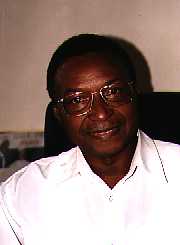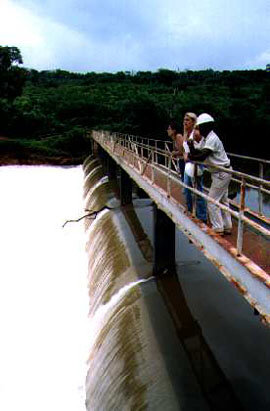 ENVIRONMENT ENVIRONMENT
 ENVIRONMENTAL CONCERNS ENVIRONMENTAL CONCERNS
Guinea’s natural resources and energy sector’s hopes remains in the hands of foreign investment. Plenty of natural resources are just waiting to be exploited such as the estimated 4 billion tons of iron ore distributed between Simandou and Nimba mountains, in the border with Sierra Leone. However environmentalists are concerned about the impact of indiscriminate mining. Mt Nimba - the highest mountain in Western Africa is entirely made of iron and is hence seen by the government as an excellent source of revenue. But it is also a sacred to the tribes of the forest region and in its jungles house endangered chimpanzees and the only vivipare toads known in the world.

Companies such as Friguia and SBG are environmentally conscious and have designed programs to reforest the mining areas already exploited. Used water treatment and waste controls also follow international standards.
The Ministry of Public Works, also responsible for the environment, has serious reasons to worry. Thousands of rundown vehicles circulate unchecked expelling clouds of toxic emissions. But this is still a minor concern. Population grows at a fast pace, increasing the need for more arable land. Burning is the traditional method in Africa to procure farm land and fertilize it. Furthermore, 85% of Guineans use firewood as the sole means of energy, cutting down entire forests in order to heat their food. As a consequence of all this the desert advances at a vertiginous speed and rain frequency diminishes. Guinea, known as the water castle of Western Africa, warns Mr. Ousmane, General Manager of SONEG , risks to become a semi-desertic country like its neighbors Mali, Senegal or Burkina Faso. The government has recently started a program to educate and sensitize farmers to stop destroying their environment. Of its success depend future generations.
 DRINKABLE WATER IN EVERY CITY... DRINKABLE WATER IN EVERY CITY...
Fight against poverty starts invariably by the distribution of water to the population for cultivation, drinking and energy production. In 1987 only 40% of the population of Guinea had access to drinking water. Only 7 cities out of 30 were connected to water mains. Due to the dubious quality of water, cholera epidemics where not unusual. After 3 years of negotiations with the World Bank , SONEG (Société Nationale des Eaux de Guinée) was born.
Since 1989 SONEG’s role has been to identify, prepare and finance projects destined to supply the population with drinkable water. SEEG (Société d'Explotation des Eaux de Guinée) has been contracted by SONEG to execute these projects - water treatment, transport, distribution and commercialization. Whereas SONEG is a state owned company, SEEG is 51% private. Their cooperation has been a total success. The World Bank has even mentioned them as an example to be followed by developing countries.
|
After 9 years of operations, 24 cities are being served. By the year 2000 this number will increase to 30. In Conakry the number of inhabitants has grown exponentially from 700,000 in 1985 to 1,7 million in 1998, a fact that posed even more problems. Today 80% of the city’s population has access to drinking water. The water main net has been 75% renewed (previous main system dated from colonial times), and tap water is perfectly healthy. All this has been done with the help of international donor agencies such as the WB, Banque Africaine de Développement, Agence Française de Développement, Banque Européenne d'Investissement, KFW (Kredit Anstalt fur Wieder Aufbau) and Arab countries. SONEG is responsible for the repayment of this debt.

The biggest challenge is to supply not only the main cities, but the entire country with drinking water. However the project might or might not be executed by SEEG, since their contract with SONEG will finish in July 1999. In view of the results it is likely it will be renewed, but an international bidding is not discarded.
 ...AND DRINKING WATER IN EVERY VILLAGE ...AND DRINKING WATER IN EVERY VILLAGE
If SONEG is responsible for water management in the cities, the difficult task of bringing drinking water to the villages resides on the Service National d'Aménagement des Points d'Eau (SNAPE ), an autonomous organism under the supervision of the ministry of agriculture. The World Bank together with the World Health Organization (WHO) determined Guinea needed to build 6,100 water sources in 15 years to be able to meet WHO’s standards of 10 liters/person/year. IRAG successfully built the 6,100 wells, damns, pumps and canals in 13 years. By the year 2000 drinking water points should increase to 12,000.
The success of SNAPE, according to its General Manager, Mrs. Fatoumata Binta Diallo, is due to a wise marriage between the SNAPE, responsible for the planning and fund rising for the projects and the private enterprises selected for the execution of the projects. International donor organizations have furnished the necessary funds for the success of the enterprise.
Problems encountered? Indeed. Farmers, most of them illiterate, cannot understand why they should pay for water, since it is free in nature. The drinking water concept is difficult to explain to people who have always drank from the nearest water hole. An educational program is currently going on to explain to them that many of the rivers or fountains are possibly polluted due to animal excrements or garbage. |

